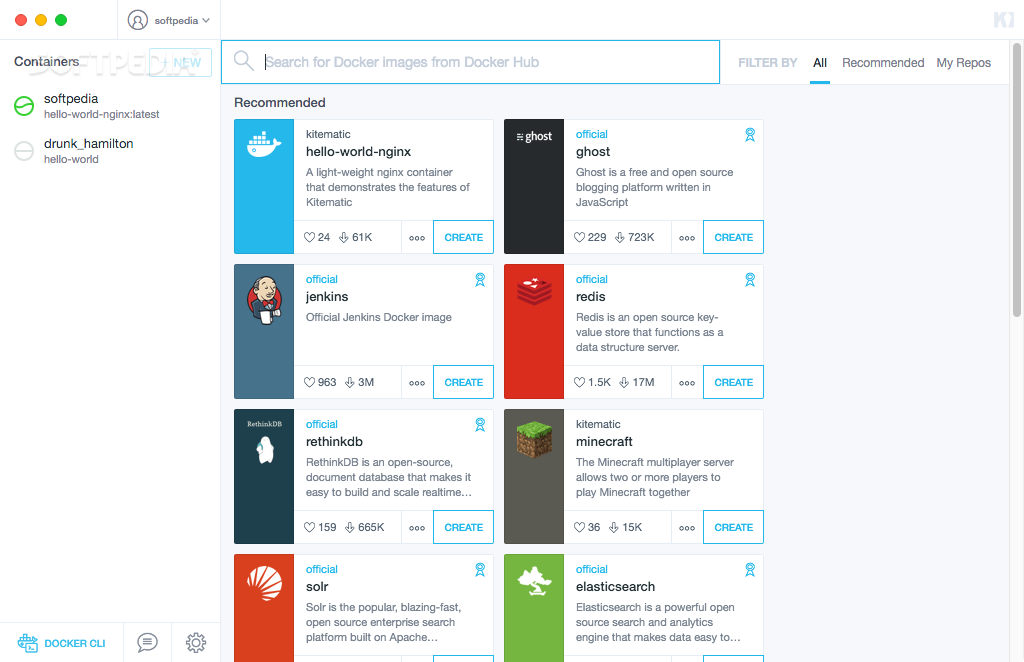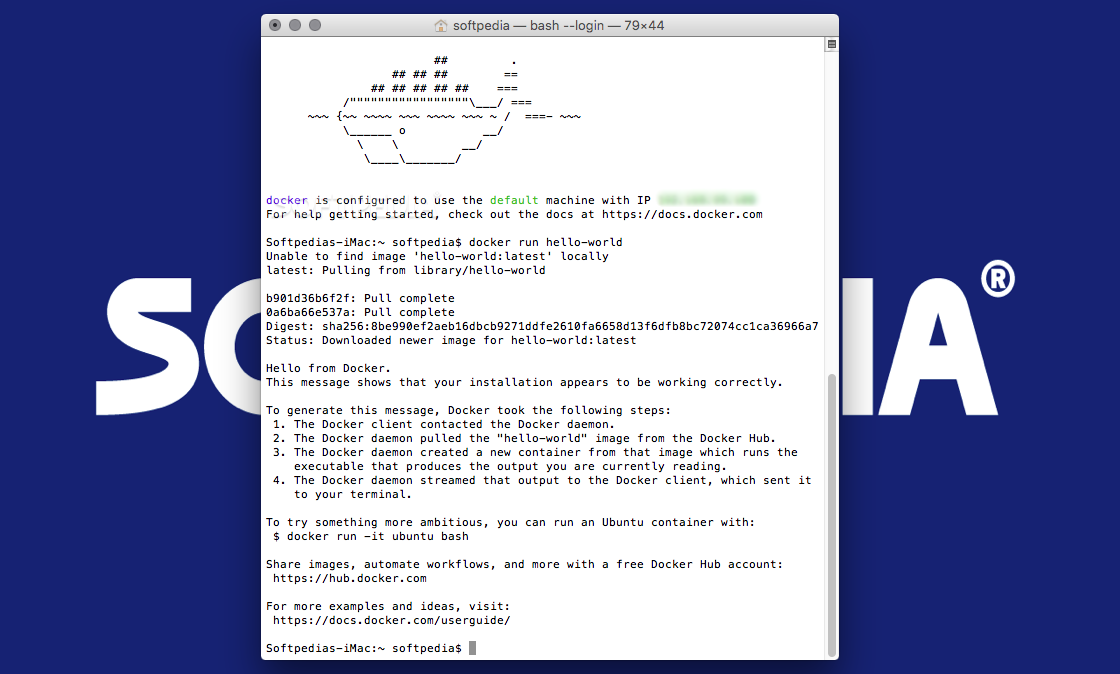
Since June 20th, 2016, are now publicly available. You can download them at To celebrate Docker’s third birthday, today we start a limited availability beta program for Docker for Mac and Docker for Windows, an integrated, easy-to-deploy environment for building, assembling, and shipping applications from Mac or Windows. Docker for Mac and Windows contain many improvements over Docker Toolbox. Faster and more reliable: no more VirtualBox! The Docker engine is running in an Alpine Linux distribution on top of an xhyve Virtual Machine on Mac OS X or on a Hyper-V VM on Windows, and that VM is managed by the Docker application. You don’t need docker-machine to run Docker for Mac and Windows.
Tools integration: Docker for Mac is a Mac application and Docker for Windows is a Windows application, including a native user interface and auto-update capability. The Docker tool set comes bundled with it:,. Volume mounting for your code and data: volume data access works correctly, including file change notifications (on Mac inotify now works seamlessly inside containers for volume mounted directories). This enables edit/test cycles for “in container” development. Easy access to running containers on the local host network: Docker for Mac and Windows include a DNS server for containers, and are integrated with the Mac OS X and Windows networking system.
Current State of Affairs. Currently, to use Docker on Mac and Windows requires the use of Docker Toolbox. You have to download it, install a bunch of tools.
On a Mac, Docker can be used even when connected to a very restrictive corporate VPN. Docker for Mac was architected from scratch to be able to fit the OS X sandbox security model and we are working closely with Apple to achieve this. See Docker for Mac and Docker for Windows in action in this video: Docker for Mac can be used at the same time as Docker Toolbox on the same machine, allowing developers to continue using Toolbox as they evaluate Docker for Mac. On Windows you need to stop Toolbox before using Docker for Windows.
Docker for Mac and Windows have already been used by a few private beta testers and they have enhanced developers’ daily workflows. “The Docker for Mac product has addressed all of these issues for us:. installation has been significantly smoother thanks to the native Mac application and autoupdater. official images now “just work” with the Mac. the new development workflow allows engineers to quickly spin up new versions of services and develop software natively on the mac against them, with everything just working.” –, Co-founder, Mixcloud You can sign up for today.
This is a limited availability private beta and signing up will add you to a waiting list. We will add more people from the waiting list on a rolling basis as we get feedback and improve the product quality. Docker for Mac and Docker for Windows are at different stages of development, although they do share a significant code base. Docker for Windows will initially be rolled out to users at a slower pace but will eventually offer all the same functionality as Docker for Mac. Docker for Windows currently only ships on Windows 10 editions that support Hyper-V. Making things easy to use and functional takes elaborate engineering work: what makes Docker for Mac and Windows feel native are deep integrations with the host system in terms of virtualization, networking, security and file-systems.
These integrations leverage the systems and virtualization expertise of Docker’s recently acquired team, as well as the Unikernel-related technologies they developed over the past 5 years: for example, the translator between Linux and Mac OS X networking uses the. Expect to see more of that kind of work in the future across the Docker line of products. All of the OS-level integration innovations will be open sourced to the Docker community when these products are made generally available later this year.
Install Docker For Mac
As usual with software, we’re building on the shoulders of giants: we would like to thank Apple and Microsoft for their assistance integrating their platforms with Docker, Michael Steil for xhyve, and the Docker product development teams in San Francisco, Cambridge, and Paris. By Patrick Chanezon is member of technical staff at Docker Inc. He helps to build Docker, an open platform for distributed applications for developers and sysadmins.
Software developer and storyteller, he spent 10 years building platforms at Netscape & Sun, then 10 years evangelizing platforms at Google, VMware & Microsoft. His main professional interest is in building and kickstarting the network effect for these wondrous two-sided markets called Platforms. He has worked on platforms for Portals, Ads, Commerce, Social, Web, Distributed Apps, and Cloud. More information is available at. Patrick tweets at. 79 Responses to “Docker for Mac and Windows Beta: the simplest way to use Docker on your laptop”. Nicholas Stein Thank you so much.
My Windows 10 pro machine will not allow me to uninstall Hyper-V. It rolls back upon reboot. That means when I run Toolbox, I get the VirtualBox error. With VirtualBox installed, Hyper-V cannot properly install a Virtual Switch. So I am trying to get started only using the command line and installing a downloaded version of Linux (Ubuntu) which has more than I want on my Docker machine. Do I really need a full Linux UI just to run a process? I am really hopeful that this beta will release me from VirtualBox.
BTW, I am getting lots of comments on my BDay3 Tee, and the contest materials, along with the help I received at the Irvine CA meetup have been super helpful. Thank you again.
Stan Towianski Hmmm. Well, I tried the docker-machine stuff and that is just too much of a pain to use when it comes to networking if I remember rightly.
I had my docker 'user' inside my virtual-machine inside my mac and that extra layer of VM was just a pain. Which user am I now??
Which network is it?? So I moved to docker for mac. That would be better; just one level of 'which user am I?' I am running into blow out problems though.

I have a mac with 16gb and docker 1.12.0-a I am using the standard Jenkins 2.7.x in docker image. My mac starts up running about 3.8gb. I start jenkins and it goes to 7.9gb I start building 2 jobs and it was hitting about 14gb and sometimes 15gb.
Problem: 2 or 3 times it just blew out; docker container stopped and it did not release system memory. Maybe I need more memory, but right now with 1 job running top says it is at 8.7gb. Maybe it does not release memory too well? Leave a Reply.
Guide to Choosing the Right Docker Release for Your OS As a cross-platform application container runtime, Docker CE (Community Edition) can be installed on Windows, MacOS and Linux on your laptop, in the cloud or on a bare metal server. Depending on which operating system you’re running, if you use Windows in addition to Linux containers, and what other hypervisors are on your system, you will install Docker using a different method. If you are on Windows or Mac, it is recommended to use Docker for Windows or Docker for Mac unless you don’t meet the system requirements. These apps use the VM hypervisor native to each operating system (Hyper-V or HyperKit) and include a background process that automatically updates your Docker Engine to the latest version.
Once you have installed Docker for Windows or Docker for Mac, you can use any shell on your system, whether it’s Powershell, Command Prompt or Terminal to issue docker commands. There’s also a GUI you can access from your system tray (Windows) or menu bar (Mac) for configuring:.
Automatic startup and updates. Shared drives. CPUs/Memory allocated to Docker VMs. Network and proxy settings. Insecure registries and registry mirrors As an alternative, you would use the legacy solution – Docker Toolbox. Docker Toolbox is an all-in-one installer that uses Docker Machine to spin up a VirtualBox VM, and generates a key for the Docker Quickstart Terminal (CLI) and Kitematic (GUI) on your host machine to communicate with the Docker Engine.

On the contrary, Docker for Windows and Docker for Mac do not use Docker Machine because they manage and update the VM directly, instead of provisioning it via the VirtualBox driver. The current (non-Toolbox) implementations of Docker have also spun out, a desktop app used to discover and manage containers, into a.
Understanding the Docker Release Cycle Stable vs Edge Releases In early 2017, Docker switched over to a versioning nomenclature like the one used by Canonical, the developers of Ubuntu. The major version number ( 17.07.0) represents the year of release, minor version number (17. 07.0) is the month of release, and the final digit (17.07. 0) is for indicating bug fix releases.
Stable releases come out quarterly, and Edge releases come out monthly. When you install Docker for Windows or Mac, or add the repository to your Linux distribution, you can select the Stable or Edge channel depending if you are running in production, or testing the latest features. Windows Windows 10 Pro/Enterprise Virtualization engine: Microsoft Hyper-V Windows Server 2016 is officially supported in. Switch between running Linux and Windows containers. Linux Docker Engine installed in an Alpine Linux VM; Windows Containers leverage containers support in Windows 10. Hyper-V must be enabled – must not be using VMware or VirtualBox.
Execute docker commands from Powershell or Command Prompt. No need to manually add environment variable. Background app automatically checks for updates to Docker components Windows 10 Home, Windows 7, Windows 8/8.1 Virtualization engine: Oracle VirtualBox. Docker Engine runs inside a VirtualBox Linux VM.
Supports Linux containers only, not Windows containers. If VirtualBox is not present on the system, it can be installed by the Toolbox. Execute docker commands from Command Prompt after adding C: Program Files Docker Toolbox to the Environment PATH variable. Manage containers from Docker Quickstart Terminal or Kitematic.
Check for updates by running Toolbox installer MacOS OS X El Capitan 10.11 or greater 2010 or newer Mac, with minimum 4 GB RAM Virtualization engine: HyperKit. Mac-native application that installs directly in your Applications folder. Generally better performance, compatibility with system time and power settings.
Docker Engine runs in an Alpine Linux VM virtualized in HyperKit. Can run in parallel with VirtualBox version 4.3.30 or greater. Execute docker commands from Terminal. No need to manually add environment variable.
Background app automatically checks for updates to Docker components Virtualization engine: Oracle VirtualBox. Docker Engine runs in a VirtualBox Linux VM.
Execute docker commands from Terminal after adding the following environment variable: eval $(docker-machine env default). If VirtualBox is not present on the system, it can be installed by the Toolbox. Check for updates by running Toolbox installer Linux Ubuntu, Debian, Fedora or CentOS Recommended install method: Native apt or yum Linux package from Docker’s official repositories. Why shouldn’t you install Docker from your OS’ default repositories? The versions are much out-of-date compared to Docker’s Stable release, and you won’t have access to Edge versions for testing. Red Hat Enterprise Linux (RHEL), SUSE Linux Enterprise Server and Oracle Linux are officially supported. No virtualization – best performance for running Linux containers in production.
File system mounts (container host) do not have overhead of a hypervisor. Add Docker’s repository and GPG key to download binaries over HTTPS.
Super Docker For Mac
Docker can be updated to the latest version or held back via package manager. Docker Engine installed separately from Docker Compose. Issue docker commands from any shell.
Current user needs to be added to docker user group to run docker commands without sudo.
